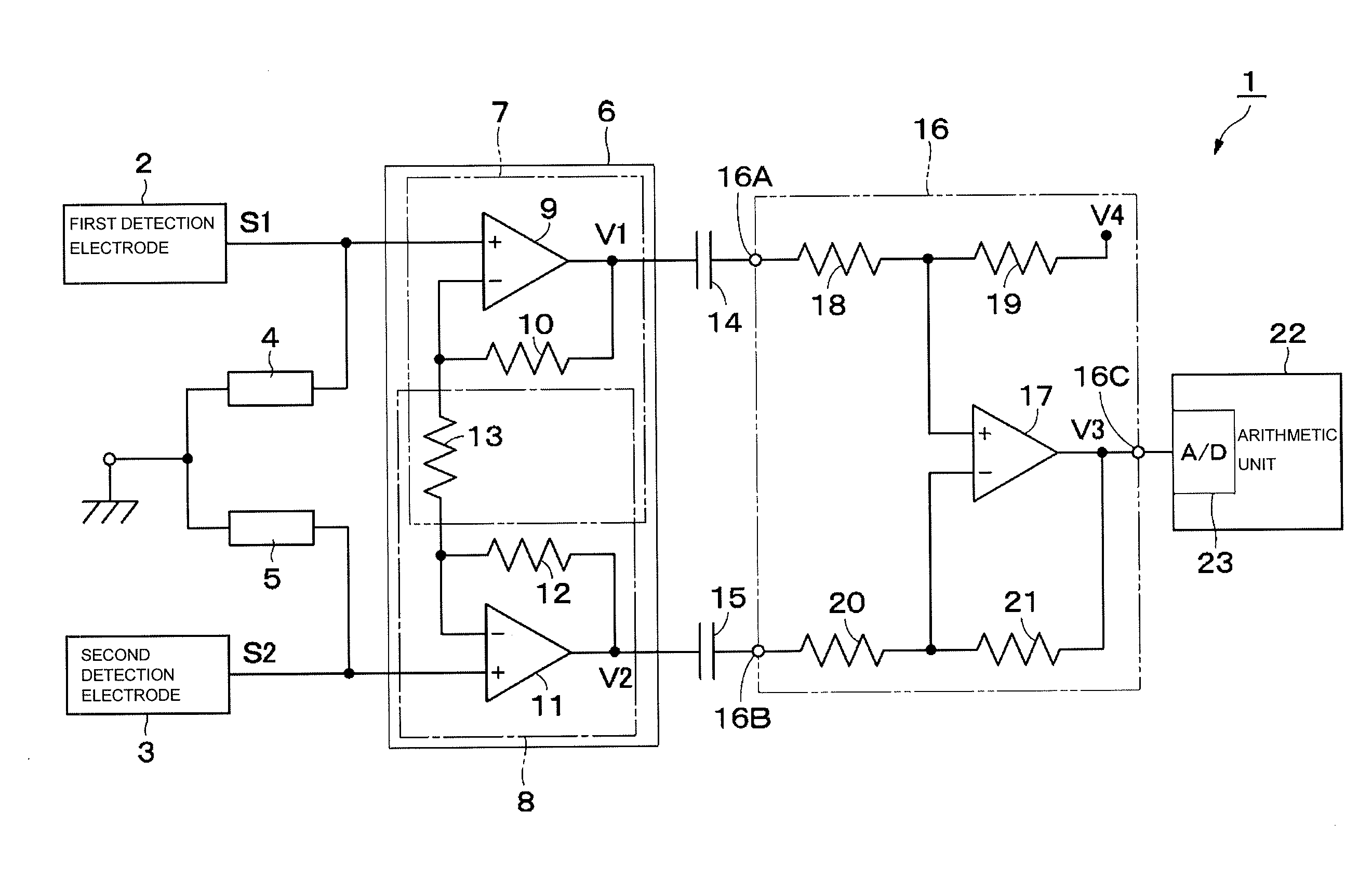Detection circuit
a detection circuit and circuit technology, applied in the field of detection circuits, to achieve the effect of reliably determining peak values
- Summary
- Abstract
- Description
- Claims
- Application Information
AI Technical Summary
Benefits of technology
Problems solved by technology
Method used
Image
Examples
first embodiment
[0034]the present invention is illustrated in FIG. 1. A measurement device 1 includes first and second detection electrodes 2 and 3, first and second high impedance circuits 4 and 5, an amplifier circuit 6, first and second coupling capacitors 14 and 15, a differential amplifier circuit 16, and an arithmetic unit 22.
[0035]The first and second detection electrodes 2 and 3 are formed using, for example, a conductive film including a conductive metal material or a conductive resin material. The first and second detection electrodes 2 and 3 are attached in a state of being in direct contact with the different body surfaces of the person to be measured. The first detection electrode 2 detects a first detection signal S1 serving as an analog signal, from a first body surface. In addition, the second detection electrode 3 detects a second detection signal S2 serving as an analog signal, from a second body surface.
[0036]The first high impedance circuit 4 is configured using, for example, a ...
second embodiment
[0067]In addition, while, in the second embodiment, a configuration is adopted where the amplification factors of the first and second amplification units 33 and 34 are controlled by the single AGC circuit 38, AGC circuits may also be provided that control the first and second amplification units 33 and 34 separately.
[0068]Next, a third embodiment of the present invention will be illustrated in FIG. 4. The third embodiment is characterized by a configuration where the resistance value of a single variable resistor is adjusted by an automatic gain control circuit and the amplification factors of first and second amplification units are simultaneously controlled. In addition, in the present embodiment, the same symbol will be assigned to the same configuration element as in the above-mentioned first embodiment, and the description thereof will be omitted.
[0069]In substantially the same way as the measurement device 1 according to the first embodiment, a measurement device 41 includes ...
third embodiment
[0082]An amplifier circuit 52 is configured in substantially the same way as the amplifier circuit 42 and includes a first amplification unit 53 including the operational amplifier 9 and so forth and a second amplification unit 54 including the operational amplifier 11 and so forth. In addition, the inverting terminals of the operational amplifier 9 and the operational amplifier 11 are connected to each other through a variable resistance element 55. Furthermore, the output terminal of the first amplification unit 53 is connected to the first input terminal 16A of the differential amplifier circuit 16 through the first coupling capacitor 14, and the output terminal of the second amplification unit 54 is connected to the second input terminal 16B of the differential amplifier circuit 16 through the second coupling capacitor 15.
[0083]In addition, the first amplification unit 53 configures a non-inverting amplifier circuit using the operational amplifier 9, the resistor 10, and the va...
PUM
 Login to View More
Login to View More Abstract
Description
Claims
Application Information
 Login to View More
Login to View More - R&D
- Intellectual Property
- Life Sciences
- Materials
- Tech Scout
- Unparalleled Data Quality
- Higher Quality Content
- 60% Fewer Hallucinations
Browse by: Latest US Patents, China's latest patents, Technical Efficacy Thesaurus, Application Domain, Technology Topic, Popular Technical Reports.
© 2025 PatSnap. All rights reserved.Legal|Privacy policy|Modern Slavery Act Transparency Statement|Sitemap|About US| Contact US: help@patsnap.com



